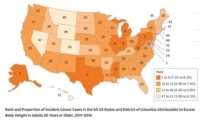Occupations with high obesity prevalence in Washington State
A NIOSH Science Blog post

 By Wendy Lu, MPH; David Bonauto, MD, MPH; Joyce Fan, PhD;Casey Chosewood, MD and Sara E. Luckhaupt,MD, MPH
By Wendy Lu, MPH; David Bonauto, MD, MPH; Joyce Fan, PhD;Casey Chosewood, MD and Sara E. Luckhaupt,MD, MPH
If work and the workplace contribute to poor health behaviors, should employers attempt to improve those behaviors? It likely is in the employer’s best interest to do so.
Poor health behaviors can lead to chronic disease. Workers with chronic disease may be at higher risk for workplace injury, have more absenteeism, and diminished productivity at work. Once injured, workers with chronic diseases take a longer time to return to work. So the best strategy would be for employers to promote healthy behaviors to prevent the occurrence of these chronic diseases.
Many state health departments offer chronic disease prevention programs. Surprisingly, there is a dearth of state-level information about the health behaviors of workers across occupations. We recently presented findings from a research study where the main objective was to estimate the level of obesity and other worker health behaviors by occupation in Washington State. We used the Behavioral Risk Factor Surveillance System (BRFSS) survey for this research. BRFSS is the world’s largest telephone health survey and a nationwide surveillance system, collecting on-going behavioral information in the U.S. and providing valuable public health data.
The prevalence of obesity among all Washington workers was 24.6%. However, the prevalence of obesity across occupations ranged from 11.6% to 38.6%. The three occupational groups with the highest obesity prevalence were:
- Truck drivers, 38.6%.
- Transportation and material moving (bus drivers, crane operators, etc), 37.9%.
- Protective services (for example, firefighters, police officers and correctional officers), 33.3%.
When compared to health diagnosing occupations (physicians and dentists, for example) and after adjusting for other covariates, most occupations had significantly increased odds of obesity.
Inclusion of occupation on the BRFSS allows estimation of the prevalence of current smoking, adequate fruit and vegetable intake, and leisure time physical activity levels. Based on these measures, specific occupational groups can be evaluated against national and state efforts at promoting workplace wellness. For example, of the 28 occupational groups, 10 had already met the Healthy People 2020 goal for smoking prevalence at less than 12%.-
Using occupation as a means to target workplace wellness and health promotion activities makes sense when you look at...Click here to read the rest of the post.
Looking for a reprint of this article?
From high-res PDFs to custom plaques, order your copy today!







